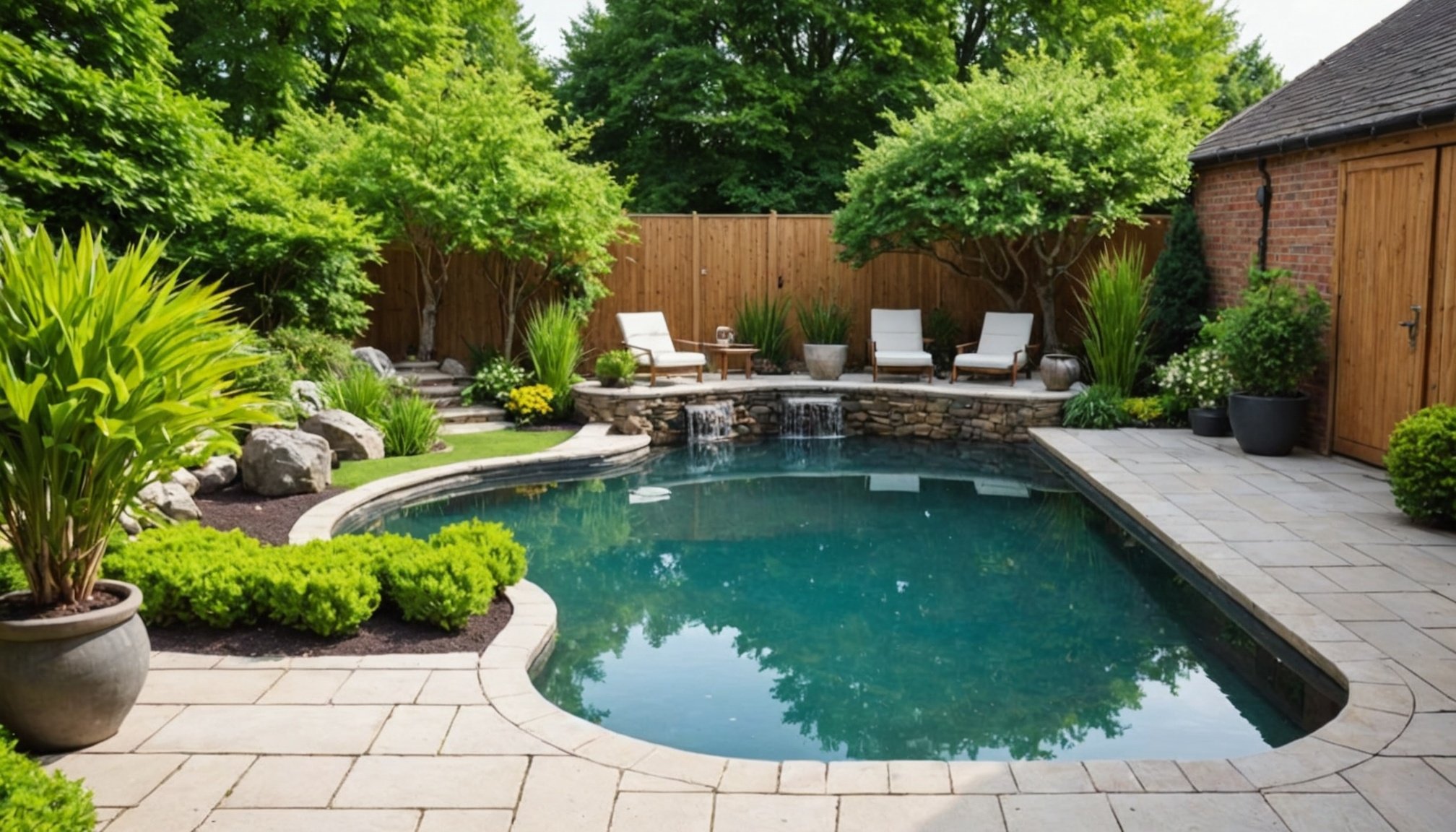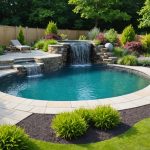Understanding the Zen Garden Concept
Zen gardens, also known as Japanese rock gardens, are spaces designed to promote tranquility and outdoor relaxation. They are characterized by meticulous arrangements of rocks, sand, and gravel that are raked to represent ripples in water. These gardens often include elements like water features, bonsai trees, or simple vegetation to enhance their serene ambiance. A true Zen garden adheres to specific principles, emphasizing simplicity and naturalness, allowing it to serve as a meditative space.
Psychological Benefits
The tranquility of a Zen garden offers profound psychological benefits. Engaging with such a peaceful environment can significantly reduce stress and cultivate mindfulness. The focus on simplicity helps clear the mind, fostering a sense of calm and clarity. Additionally, the act of maintaining a Zen garden, such as raking the gravel, can be meditative in itself, providing an outlet for creativity and relaxation.
A découvrir également : Creating the Perfect Family Oasis: Designing a Chic and Safe Pool for Your UK Home
Inspiration from Traditional Aesthetics
Drawing inspiration from traditional Japanese garden aesthetics, these gardens emphasize harmony between nature and humanity. They seek to encapsulate the essence of nature’s beauty within a compact space, creating a personal sanctuary for outdoor relaxation. Thus, adopting Zen garden principles brings the tranquility and simplicity of nature closer to everyday life, enriching one’s mental well-being.
Assessing Your Current Pool Area
Before diving into any enhancements, it’s crucial to undertake a pool evaluation. Begin by examining the existing landscaping and pool features. Are the current elements functioning as desired, or do they detract from the overall ambience? Conducting a comprehensive design assessment helps pinpoint these issues and sets the stage for improvement.
A lire également : Transform Your UK Garden: Creative Ideas for Designing a Stunning Pool with a Waterfall Feature
When evaluating, consider the plants, furniture placement, and available shade. These factors can significantly influence poolside comfort and aesthetics. Identifying opportunities for enhancement might involve updating plants or adjusting furniture to improve space utilization. Remember, optimizing the surrounding space fosters a more inviting and serene environment.
Space optimization isn’t just about rearranging; it’s about creating a balance. Assess how features like walkways and decks unify the area. Perhaps there’s an opportunity to incorporate water-efficient plants or modern materials to enhance the pool’s appeal. This not only boosts aesthetics but also supports efficient space utilization.
Consider how each element of the pool area contributes to the relaxation and enjoyment it offers. A well-thought-out design assessment can uncover simple adjustments that make a significant impact, ensuring every inch of space serves a purpose and enhances the overall experience.
Designing Your Zen Oasis
Creating a Zen garden design involves careful selection of elements to foster tranquility. One essential feature is the layout planning of your garden pool area. Consider adding soothing water features such as a small waterfall or a reflective pond, which can enhance serenity. Traditional elements like stone arrangements and sand gardens provide a meditative focus and are foundational to Zen landscapes.
Spatial arrangements play a crucial role in aesthetic harmony. Opt for asymmetrical balance—an approach that is pleasing and inviting. Begin with a path leading to the pool area, incorporating curved lines to mimic natural forms, which guides the eye gently through the space. Incorporating seating, like benches made from natural materials, invites rest and reflection.
Achieving aesthetic harmony also requires a thoughtful blend of colors and textures. Utilize a subdued palette—greens, greys, and earth tones dominate. Introduce various textures with pebbles, sand, and moss for an engaging tactile experience. By integrating these elements, you create an environment that not only delights the senses but also fosters peace and mindfulness, allowing each visitor to find their own oasis of calm in the garden.
Selecting Suitable Plants
Creating a Zen-inspired garden requires meticulous plant choices that harmonize with both the UK climate and the desired garden aesthetics. In the UK, it’s essential to choose plants that not only survive but thrive in the local conditions. Key options include Japanese maples, bamboo, and ferns. These plants reflect the tranquility of Zen gardens while being compatible with the temperate climates found in various UK regions.
Strategically considering plant placement and groupings can enhance this calm atmosphere. For instance, placing bamboos against a backdrop of a stone wall can create a serene screen, while clusters of ferns provide texture and depth to garden beds. Elevate the space with flowering cherry trees, which offer seasonal colour and emphasize the principles of wabi-sabi with their impermanent beauty.
Seasonal planting is crucial to maintain the garden’s aesthetics throughout the year. In spring, the inclusion of azaleas and camellias can bring vivid bursts of colour. During autumn, Japanese maples contribute fiery hues. Regular maintenance ensures these plantings retain their health and vibrancy, preventing the garden from becoming overgrown and chaotic. Effective mulching, pruning, and winter protection are essential tasks for longevity.
Incorporating Water Features
Introducing water features into a Zen garden can transform the space into an oasis of serenity. When deciding on the right component, there are numerous types to consider, each adding its unique allure. Popular choices include koi ponds, cascading wall fountains, and traditional stone basins. Each offers a distinct calming sound, from the gentle ripple of a pond’s surface to the soothing trickle of a small fountain, each contributing to a tranquil atmosphere.
Types and Their Significance
The inclusion of water sounds plays a crucial role in creating a sense of peace. These sounds can mask more intrusive noise, offering a natural buffer that enhances meditation or quiet reflection. A steady stream or light splash can provide just the right amount of ambient sound to soothe the mind.
Design Integration Tips
Design integration is essential to ensure water features complement rather than dominate. Consider the surrounding elements and allow the water feature to blend seamlessly into the landscape. Placement is key: position features near resting areas or pathways where visitors can easily engage. Balancing aesthetics with functionality can create an inviting retreat that prioritizes harmony and mindfulness in your Zen garden.
Choosing Furniture and Accessories
In crafting a Zen-inspired space, the selection of outdoor furniture plays a key role in establishing an atmosphere of tranquility. Begin by considering furniture that boasts minimalist design. The absence of complex patterns or bright colours helps maintain serenity. Opt for pieces that feature clean lines and neutral tones, ensuring they blend seamlessly with nature.
Zen accessories like stone gardens or small, carefully arranged plants can enhance this calming environment. These functional decor elements not only add aesthetic value but also serve a purpose in creating a meditative setting. The aim should be to promote relaxation and mindfulness through simplicity.
When choosing decorative elements, focus on those that enrich the tranquil feel of the area, such as water features or candle lanterns. Functional decor is essential, as it balances beauty with utility. Keeping accessories simple contributes to the overall idea of a Zen garden, where nothing is superfluous.
By harmonizing these aspects—outdoor furniture, Zen accessories, and functional decor—you can transform your garden into a peaceful retreat. Let every element contribute to the overall sense of calm, turning your outdoor space into a true embodiment of the Zen philosophy.
Maintenance for a Tranquil Zen Garden
Maintaining a Zen garden to ensure it remains a serene oasis involves a thoughtful approach to garden maintenance and seasonal care. Essential tasks include regular raking of gravel to maintain its neat lines and removing debris or fallen leaves from the pool area. This simple practice restores order and enhances tranquility.
During different seasons, plant care requires specific attention. In spring, prune any overgrown shrubs and fertilize to encourage new growth. As summer arrives, consistent watering becomes crucial to sustain plant health. During autumn, removing dried leaves is vital for cleanliness, while winter calls for protecting delicate plants from frost.
Minimizing maintenance while maximizing tranquility can be achieved through strategic planning. Choose low-maintenance plants native to your area, requiring less water and care. Consider installing an automatic dripping irrigation system to ensure consistent moisture, reducing manual watering efforts. Replace labor-intensive features with simple, sustainable materials.
Regular upkeep and timely interventions enhance your garden’s beauty and invite relaxation. With mindful attention, your Zen garden will remain a place of peace and calm throughout the year. By adhering to these upkeep tips, a Zen garden retains its allure without overwhelming demands.
Inspiring Case Studies
Allowing your mind to wander, even briefly, in a Zen garden can provide tranquility and clarity. In the UK, many have successfully used transformation examples as guides for crafting personal sanctuaries. These gardens stand out not only for their serenity but also for their successful designs that reflect both creativity and tradition.
In one notable case, a modest urban backyard was completely transformed into a visual inspiration by incorporating meandering pathways and soothing water features. Each element was meticulously chosen to contribute to the garden’s overall sense of peace. Another example involved the use of bamboo fences and gravel to evoke a sense of privacy and introspection, demonstrating the impact of simple, natural materials in design.
To infuse these insights into personal projects, understanding the essential design elements is crucial. Start by selecting elements like stones, water, and specific plants that align with your vision of tranquility. Applying these ideas from case studies enables you to create an environment that reflects your own visual inspiration, making it both a personal retreat and a reflection of successful Zen garden principles. Utilize these examples to channel creativity and achieve your version of a peaceful haven.











